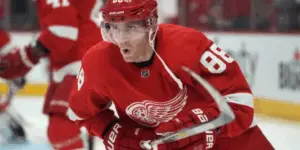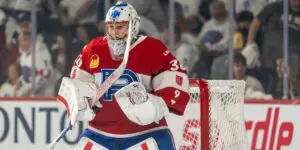
The 2023-24 season has been a rollercoaster of a start for the Anaheim Ducks. The start of the season saw them drop four of their first five games and follow it up by winning their next six in a row. As of today, they’ve dropped 13 of their last 14 and haven’t won a game in regulation since the 14th of November when they defeated the Predators in Nashville. In the division standings, the Ducks sit at the bottom of the Pacific, and in the overall NHL standings, they are second from the bottom. Having just passed the 1/3 mark of the 82-game season, one is left to wonder what is going on with the Ducks. Are they closer to the team we saw win six in a row earlier in the season or the team that is currently on another five-game losing streak?
By the majority of season predictions, the Ducks are right where they should be. They have one of the youngest rosters in the NHL and are coming off the worst defensive season we’ve seen from a team during the salary cap era in 2022-23. The 2023-24 season always felt like a season of progress and process over results in terms of priority. After suffering through the worst five-year stretch in franchise history, now seems like the time to start the climb out of the basement of the league and toward contention. That process starts behind the bench for the Ducks, and despite some key injuries to young core players on the roster, they seem well on their way to their goal. That goal is to establish a culture along with an on-ice system and ensure the important young pieces of the organization are progressing and developing properly. Greg Cronin is 29 games into his tenure with the Ducks, and his impact can be felt immediately and cannot be understated.
The System
The system Greg Cronin has brought with him is of an extremely up-tempo and high-pressure style. It is modeled after what the Carolina Hurricanes and Colorado Avalanche have deployed over the last several years. It is almost identical to Colorado’s, which makes sense, as Cronin’s last head coaching job was for the Avalanche AHL affiliate, The Colorado Eagles. It is designed to pressure the puck over every inch of the 200 ft ice surface and eliminate easy options for moving pucks up ice or off the cycle.
In the defensive zone, the Ducks are playing a man-to-man coverage where defenders are glued tightly to their opponent when they have clear possession established. When the puck is low in the zone, the players covering the point men are positioned around the hash marks so they can support the puck if needed and get to their spots for a breakout. Once the team gains possession, the strong side winger and often the center will retreat to the neutral zone for a stretch pass or high flip exit, while the weak side winger will head to the opposite board for a potential rim around the end wall. Weak-side defensemen are encouraged to activate as an option on the breakout for a pass from their defensive partner and join/lead a rush. The main objective involves moving the puck from the defensive zone as quickly and efficiently as possible.
As is with most teams in the modern NHL, the forecheck is prioritized heavily as a form of generating offense. The Ducks will often redirect those stretch passes or high flips deep into the offensive zone. Once the puck is low in the zone, two forwards aggressively fly low to pressure the defensemen behind the goal line. The forward closest to the puck pressures the puck-handling defenseman, while the second pressures his partner to eliminate that option. The third forward stays higher in the zone toward the middle of the ice to read where the puck will be moved. Once the puck is moved up the wall, the strong-side defenseman activates to pressure, cut off, or battle at the half-wall. The high forward (F3) fills in for him at the point. The objective of this forecheck is to pressure the puck at every juncture and manufacture turnovers so scoring chances can be created before the opposition gets into their defensive structure.
In the offensive zone, creativity is the priority. With the amount of talent on the Ducks roster, allowing players like Troy Terry, Leo Carlsson, Trevor Zegras, and Mason McTavish to operate without constraints seems like the optimal route to manufacturing offense. When the puck shifts from low in the zone to the point, they like to have the high forward pop out to the high slot as a shooting option and, more importantly, draw defenders away from the opposing net to create mismatches low in the zone.
Lastly, the set neutral zone forecheck is a twist on the popular 1-2-2 setup where the objective of the F1 forward is to pressure the puck carrier and discourage D-to-D passes. The F2 and F3 forwards play a pressuring man-on-man coverage on the swinging wingers, so they can’t cleanly receive passes in the neutral zone with speed. And the two defensemen eliminate the opposing F1 option and pounce on loose pucks from inaccurate passes. The objective here is to eliminate time, space, and options as the opponent attempts to generate rush opportunities and to force turnovers or, at the most, dump-ins.
Fatigue
As one can imagine, new head coach Greg Cronin’s play style and system for the Anaheim Ducks can be taxing on a player’s body. From all accounts, training camp was rigorous, and there was communication during the summer between the coaching staff and roster on what was expected from each individual from a mental and physical perspective. Constantly applying pressure on the puck over the entirety of the ice sheet on every shift has proven to be an effective tactic, but it has the potential to be tiring on a nightly basis.
While there are several veterans on the team like Cam Fowler (32), Ryan Strome (30), Radko Gudas (33), etc., the Anaheim Ducks still ice a relatively young roster, including six rookies and nine players under 24 years old. The schedule can be daunting for players who came into 2023-24, never having played a full NHL season. 82 games compressed into six months means teams play 13-14 games per month on average; that’s at least 4-5 games more per month than most professional, college, or junior leagues.
On a nightly basis, the Ducks have adopted their pressure system well enough. They aren’t allowing nearly as many high-danger chances (especially off the cycle) and are creating opportunities by capitalizing on opponent’s mistakes caused by a heavy forecheck. However, if a forechecker is a split second late to his assignment or a defender gets lost in the coverage, it can be the difference between allowing a scoring chance against or producing one. That being stated, one has to wonder if the physically taxing element of it has caught up with some of the players on either end of the age spectrum.
Injuries
There isn’t a team in the NHL that hasn’t been bitten by the injury bug in one way or another. For the Anaheim Ducks, those bitten the worst have been three former top 10 overall draft selections: forward Trevor Zegras, defenseman Jamie Drysdale, and center Mason McTavish. Zegras has missed the team’s last 17 games with a lower-body injury, Drysdale has missed the last 27 with a lower-body injury, and McTavish has missed the previous five with an upper-body injury. In total, that adds up to 49 man-games missed from those three players. Center Isac Lundestrom remains on injured reserve after suffering a torn Achilles during off-season training.
There have been several minor injuries along the way as well, including to goaltender John Gibson and forward Max Jones. But the previously mentioned have been the most significant. Losing two top-six forwards and a top-pairing defenseman for significant time would be detrimental to most teams in the NHL. Especially so for the Ducks, who are relatively thin when it comes to finding offense lower in the lineup.
Trevor Zegras had only produced two points in the team’s first 12 games but had totaled north of 60 points in each of his first two seasons in the NHL on teams bereft of offense. Though the scoresheet evaded him, he continued to generate quality opportunities and was one of the team’s better defensive forwards before being sidelined. The ripple of that particular loss was felt throughout the lineup as well due to him drawing the opposition’s toughest assignments, creating softer matchups for the lower lines.
A member of one of those lines is Mason McTavish, who scored 13 points in 12 games with Zegras in the lineup. Without him in, McTavish managed eight points in 12 games before going down with injury. McTavish had become the team’s primary play-driver early in the 2023-24 season. He was winning battles in every zone, creating in transition, off the cycle, and on the powerplay. Playing without McTavish over the team’s last four games has furthered the offensive slide that had been plaguing the team of late.
Jamie Drysdale has missed all but 10 of the Anaheim Ducks last 111 games over the last two seasons. He suffered a torn labrum in his shoulder eight games into the 2022-23 season and has only managed to play two games in 2023-24 due to a lower-body injury. Drysdale was the youngest player in the entire NHL for a decent portion of the 2020-21 season and scored 32 points in 81 games during his true rookie season of 2021-22. Drysdale has shown he will dedicate himself to his craft both on and off the ice to improve his game and become the best version of himself in the NHL. During the eight games of the 2022-23 season before going down with his shoulder injury, he had already made vast improvements to his game. The areas that plagued him in his rookie season were no longer present. Those things like getting beat out of corner battles, getting outmuscled in front of the net, and respecting the elite talents (Connor McDavid, Nathan MacKinnon, Auston Matthews, etc.) of the league too much, which led to improper gaps on the rush were eliminated from his game. In his only two games of this season, he seemed to have rehabbed diligently and had taken his game to an even higher level where he was extremely active and involved in every zone, killing plays, retrieving pucks, joining rushes, and winning battles. With him out of the lineup, the Ducks have had to rely on a combination of Jackson LaCombe playing on the right side of Cam Fowler as a left-shot defenseman (where he’s had trouble meeting the demands of the team’s system) and rookie Tristan Luneau who is similar to Drysdale in that he is active and willing to give 100% every second he’s on the ice but was still very much adjusting to the size and speed of the NHL. Luneau has joined Team Canada’s World Junior Championship roster and isn’t with the Ducks of now.
All three of these players have been practicing with the team over the last week or so and have joined them on their current four-game road trip to the East Coast. The Ducks lineup could use the injection of offense and energy these three players can provide to slow the bleeding and return to the win column with more consistency.
Looking Ahead
So, what can we pin the Ducks’ struggles on of late? Adjusting to Greg Cronin’s system and play style, injuries to key pieces, rookies going through growing pains as they adjust to the demands of NHL games and an NHL schedule, veterans attempting to rid themselves of poor habits, or taking too many undisciplined penalties at the most inopportune times? The answer is likely a KFC Famous Bowl-style combination of all those reasons. It seems clear they aren’t the team that won six games in a row, but they also aren’t the team that has lost 13 of their last 14.
It still seems like the team isn’t ready to start competing and join the playoff conversation just yet. However, the process is on track, and the team is heading in the right direction. They have been competitive in the majority of the games this season, and the younger players (Leo Carlsson, Mason McTavish, Pavel Mintyukov, etc.) are taking the necessary strides toward becoming supremely impactful pieces once the team does arrive in playoff conversations.
Greg Cronin and the coaching staff have made some slight tweaks to their tactics as well. That hasn’t been seen on the ice in Anaheim in quite a while. When Leo Carlsson is centering Troy Terry and Alex Killorn, rather than sending three forwards to the neutral zone immediately in search of a stretch pass that will ultimately be tipped or dumped deep into the offensive zone, that line has been sending two forwards to swing low on regroups so speed can be generated through the neutral zone and chances can be created off the rush. The powerplay has had a tweak of its own as well. Rather than remaining stationary in a common 1-3-1 umbrella and moving the puck predictively, they often shift from the 1-3-1 setup to a mid-2000s 2-2-1 umbrella (releasing the bumper to below the opposite circle) based on how the puck is moving around the zone. It’s a creative adjustment, and the willingness to try something of this kind should be applauded and has been rewarded late on the scoresheet as they have notched five powerplay goals in their last five games.
The blueprint for success and the foundational pieces are in place in Anaheim. From the coaching staff to the players on the roster, everyone seems to be on the same page and working toward the same goal. Growing pains are a part of the process, and injuries have caused brakes to be pumped. The goal is to work toward being a competitive team not just for a season or two but for years and even a decade to come. There hasn’t been an aspect of the season to cause concern from that perspective.
Discover more from Inside The Rink
Subscribe to get the latest posts sent to your email.



